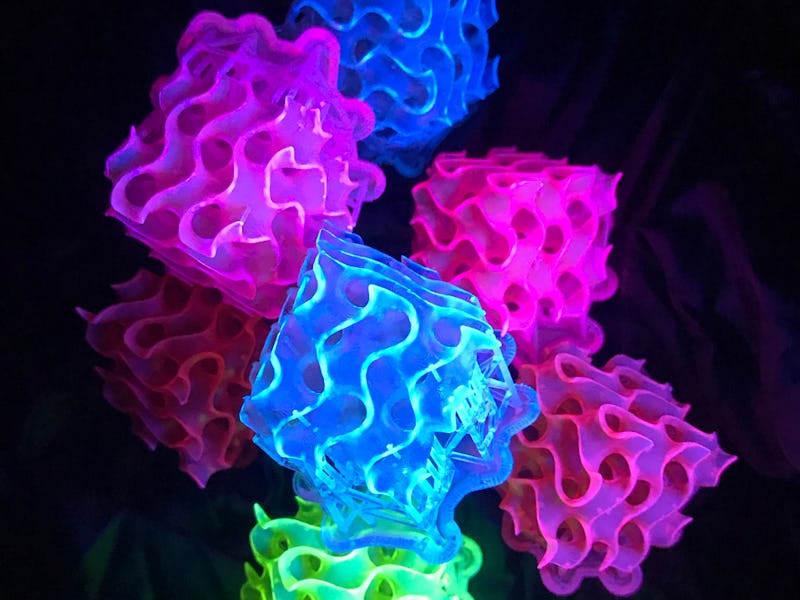Chemists solve a 150-year-old mystery; create the brightest material ever
"We also do not know the materials' limits."

The word fluorescent might bring to mind the harsh, overhead lighting of your high school at worst, or cool, glowing oceans at best, but these types of brightly glowing materials actually play an important role in everything from medical biomarkers to solar technology.
But despite their wide-applications, these materials have faced a 150-year-old struggle when it comes to transferring their properties from a liquid solution to a solid. This has limited fluorescents' overall use.
Chemists reports in a new study that this decades-long challenge is finally coming to the end thanks to a newly discovered class of materials called SMILES (small-molecule ionic isolation lattices), along with specialized scaffolding molecule. SMILES, the study suggests, are the brightest known material in existence.
The finding, published Thursday in the journal Chem, focuses on solving a familiar and resilient problem facing fluorescents called "quenching." Essentially, when multiple dyes are combined together to form a solid, they can't help but interact with each other, which lowers their fluorescence.
Amar Flood, a chemist at Indiana University and co-senior author, explains that this process can be compared to the way children behave when sat together and told to be quiet or still.
"The problem of quenching and inter-dye coupling emerges when the dyes stand shoulder-to-shoulder inside solids," says Flood. "They cannot help but 'touch' each other. Like young children sitting at storytime, they interfere with each other and stop behaving as individuals."
Research in the past has found ways to keep these mischievous dyes separate from each other, but not without adding artificial colors to the solid and compromising the overall photonic qualities of the fluorescent dye. Flood and his colleagues write that their approach is unique because it uses a colorless molecule to keep these dyes separate, maintaining their fidelity
In turn, this process could give new life to over 100,000 dyes for applications in biomedical imaging, solar energy, and more, the study suggests.
(Left) the 3D printed fluorescent objects under white light versus (right) the objects under UV light.
How it works — The trick to achieving this, write the authors, was using a colorless molecule called a cyanostar to give added structure to these chatty dyes.
The cyanostar kept the dyes from mixing as they set. This maintained their precious optical qualities and enabled them to transform into a lattice of separated molecules which the team dubbed SMILES.
They were then able to grow these SMILES into crystals and transform them into a powder that could be spun into a thin film and directly incorporated into a polymer. When the polymers were used to print 3D objects, such as abstract lattice cages seen in the photographs above, the researchers found that the dyes not only maintained their optical properties in solid form but were also the brightest materials known in existence.
"We also do not know the materials' limits."
This is more of a technicality — it doesn't necessarily mean they'll appear bright to the human eye, Flood and co-author Bo Laursen tell Inverse.
"Since fluorescence is reemission of absorbed light the perceived brightness (by human eyes) will depend on our perception of the light used to excite the material," the authors explained over email. "Fluorescence can be extremely bright when only UV light is used, in that case, the material appears as a true intrinsic light source (since human eyes cannot detect UV light)."
Instead, it can be better to compare the brightness between two different materials, say the authors. In this case, when comparing their material to one with similar glowing properties, cadmium selenide quantum dots used for medical diagnosis, the SMILES material was 30 times brighter.
This approach was also successfully applied to a number of major commercial dyes without any additional adjustments, a "plug-and-play" approach that may offer an important generalizable solution for researchers handling a vast catalog of dyes.
What's next — Despite the promising results of this initial study, the researchers caution that it is only a first step towards realizing the full potential of these dyes.
"These materials are totally new, so we do not know which of their innate properties are actually going to offer superior functionality," Flood says. "We also do not know the materials' limits. So, we will develop a fundamental understanding of how they work, providing a robust set of design rules for making new properties. This is critical for putting these materials into the hands of others -- we want to pursue crowdsourcing and to work with others in this effort."
Flood and Laursen tell Inverse that this won't be a magic fix, but that it could have major implications for existing fluorescent technologies. They anticipate SMILES will benefit the worlds of solar technology, medical diagnostics, lasers, and drug development.
"This will not solve the Covid-19 or climate challenge, but may ... contribute in the long run," the authors explain."We expect many areas using fluorescence technology to benefit from this new material."
Abstract: Fluorescence is critical to applications in optical materials including OLEDs and photonics. While fluorescent dyes are potential key components of thesematerials, electronic coupling between them in the solid state quenches their emission, preventing their reliable translation to applications. We report a universal solution to this longstanding problem with the discovery of a class of materials called small-molecule ionic isolation lattices (SMILES). SMILES perfectly transfer the optical properties of dyes to solids, are simple to make by mixing cationic dyes with anion-binding cyanostar macrocycles, and work with major classes of commercial dyes, including xanthenes, oxazines, styryls, cyanines, and trianguleniums. Dyes are decoupled spatially and electronically in the lattice by using cyanostar with its wide band gap. Toward applications, SMILES crystals have the highest known brightness per volume and solve concentration quenching to impart fluorescence to commercial polymers. SMILES materials enable predictable fluorophore crystallization to fulfill the promise of optical materials by design.
This article was originally published on